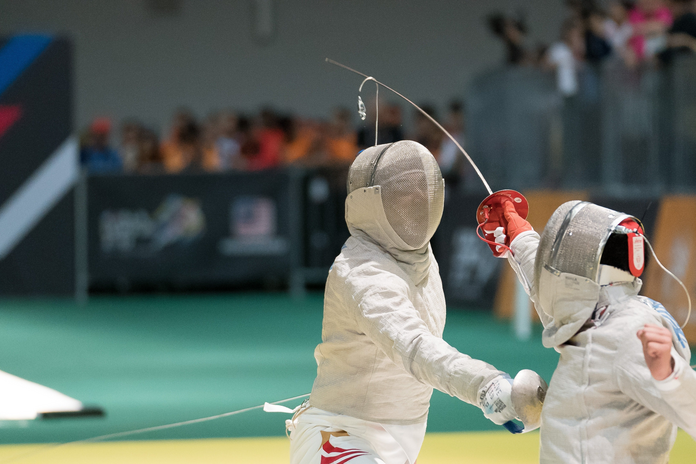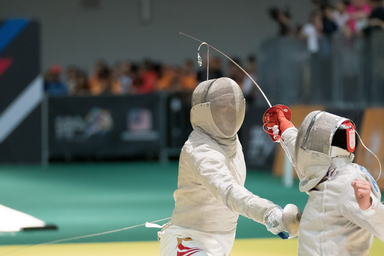MSU and UofM have had a football rivalry since 1898, meeting 113 times since. But over in the club sports, there’s an entirely different kind of rivalry: one that can be settled by dueling.
The earliest records of fencing at both MSU and UofM go back to the 1920s, and history shows two teams who took very different paths to success. One team has consistency, the other has medals. But the relationship between the two teams is friendlier than you’d expect from a sport involving three different types of swords.
MSU’s fencing narrative has been one of consistency: MSU started as recreation, went varsity, and had the best track record of attendance at NCAA championships for 45 years, despite never winning anything. They remained varsity until 1997, and then changed to being a competitive club sport. Since then, MSU has attended every club championship, but achieved few medals.
UofM never went varsity, but they hold the record for USA Club Fencing Championship (USACFC) titles and have had fencers compete in the Olympics. Their winning record is extensive, and very shiny in every fencing weapon. The rivals are two very different teams, but each with a history of dedication to the sport.
Fencing itself is very old, with historical evidence going as far as Ancient Egypt. It was a founding event of the Modern Olympiad, and has been featured in every Olympics since. Women’s foil fencing was included in the Olympics in 1924, but women’s weapons were not fully integrated until 2004. Despite the inequities in Olympic fencing, the sport as a whole is one of the best for women, as I reported for HerCampus last year (Read More).
Women’s fencing has been at the center of the UofM/MSU rivalry since I joined the MSU women’s epee team 6 years ago, and it’s been a rewarding experience to watch the relationship grow over that time. When I was a freshman, the women’s epee teams didn’t really talk to each other because we had some intense competition. I’ve always believed in being friendly to rivals, and encouraged that mentality even more when I became a captain and officer of the club team.
“People assume that rivals won’t hang out, but we’ve shared buses to nationals and done a lot of fun things together in recent years.” said Faith Chang, the women’s epee captain for UofM and my friendly rival of the last four years. Faith and I have traded bouts over the years, with her winning a large majority, but we were able to sit down and chat like it was any other day when MSU visited UofM for the UM Fall Invitational and Collegiate Newbie Tournaments last weekend.
Demonstrating her point, the groups socialized at this weekend’s events and made some memories and new friends. MSU lended one of their fencers as a referee for Saturday’s event to help the day run smoother. Just last month, the two teams joined up to get dinner at North Market after The Ohio State Invitational. Previous to that, we did joint social events via Zoom during the pandemic, and we’ll be planning another group social soon. We shared a bus to Kentucky for the USACFC Championships my sophomore year and got dinner together as a group to celebrate the wins of the weekend.
“Sometimes all it takes is just a couple of people to change the group attitude,” Faith also said. We’re at a high point in our relationship, and the exuberance of MSU Sabre was one of the larger catalysts for it. Before the pandemic hit, MSU Sabre decided to create a fan club for one of UM’s fencers, and they brought a piñata to Notre Dame to throw another UofM fencer a mini party. The piñata remains a memorable moment for both teams, and it’s thanks to the energy of a couple people wanting to be friendly.
“Unless we’re fencing, we’re friends,” says UofM co-president Molly Cavanaugh, “And even then, we respect each other,” Sookyung Heo, UofM’s other co-president, doesn’t think of our schools’ relationship as rivalry, it’s just fencing and good vibes: “Pure friendship, pure bonding,” she says.
MSU’s president Emily Lin echoes those sentiments: “We respect each other, and it’s a great relationship, especially after the piñata. I’m excited to do more together.”
The fact that the teams are so fundamentally different helps keep the rivalry healthy. The training style is different, the goals are different, and there are always bigger fish to fry. The Midwestern Fencing Conference includes several teams that train with varsity, but are club teams. And on the occasion that varsity teams are matched up with club teams during the regular season, UofM and MSU cheer each other on. At Nationals there are around 50 different teams that are matched up according to season results, including the Army and Navy teams.
It’s a tossup whether UofM and MSU will match up at regular competitions or nationals, and when it does happen, athletes fence their absolute best against each other. After our bouts, we all shake hands and move on. Holding grudges gets in the way of growth, and losses roll off easier when your rivals are friendly.
UofM Head Coach Jim Vesper sums it up nicely: “It’s a one-hour war. You put the mask on, hate each other for the three minutes it takes to fence the bout, then the masks come off, you smile, and we all have fun at dinner.”


